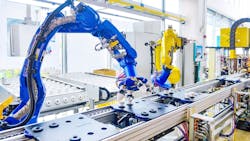According to Lauren Saidel-Baker, CFA, an economist at ITR Economics, several signals in the global economy are pointing to more positive market conditions in 2025 and beyond.
She said during the National Fluid Power Association’s (NFPA) fall economic webinar leading indicators are showing a return to growth for many markets in the coming year, including those served by the fluid power industry. This should in turn lead to a rise in shipments for hydraulics and pneumatics after the downturn experienced in 2024.
Several macroeconomic trends are influencing current projections that should be monitored to ensure proper planning is undertaken in order to realize the full potential of the opportunities that will be presented by the resurgence of growth anticipated for the remainder of the decade.
Current Macroeconomic Trends Present Need for Cautious Optimism
Saidel-Baker pointed to a number of macroeconomic trends that are bringing about better conditions for the global economy but depending on how some of them continue to play out could impact just how much growth is seen in the coming year.
Record U.S. GDP
Among the factors signaling more positive economic conditions is U.S. GDP (gross domestic product). Saidel-Baker said it is currently at a record high. The pace of its growth has been slower in 2024, but accelerated growth is anticipated again from 2025 on.
She said the U.S. is experiencing a growth economy with a very stable base due in large part to consumer spending which accounts for about two thirds of GDP. Only a very compelling risk factor would alter the consistent upward movement projected for U.S. GDP in the coming years she noted.
The U.S. accounts for about one quarter of the global economy, and thus is a key driver for current and future market conditions. Looking at other global markets, similar growth trends are anticipated in the next 2 years. Most of the world is in a recovery phase said Saidel-Baker including Canada, Mexico as well both Western and Eastern Europe. And 2025 is expected to be an accelerating growth year for the majority of the global economy. Growth will continue in 2026 as well, though likely at a slower pace.
China and India are currently experiencing the highest growth rates within the global economy, although they are slower rates than these economies are typically accustomed to said Saidel-Baker. This trend is forecast to continue in the coming years as well.
Read some of Power & Motion's recent market reports for further insights into industry sectors to watch in the coming year.
Technology Investments Driving Growth for Packaging Machinery
A Return to Growth for Mobile Hydraulics in 2025
Manufacturing Industry Projected to Grow 15% by 2028, Despite Slower Growth in 2024
Hydraulic Valve Market to Grow Over Next 10 Years
Or visit our State of the Industry page to find all of our market trend content.
Global Inflation
An aspect she said the global economy is contending with almost universally is inflation. However, it is coming down in many markets, including the U.S. and Europe, and getting closer to the Global Central Bank’s target of 2%.
She went on to explain that inflation is cumulative, so the fact that the inflation rate is currently declining does not equate to price levels declining as well. “On the consumer price side of things, we very rarely see deflation, that is outright price decline,” she said. “I would not expect prices on the grocery store shelves to go back down to where they were in 2019, that just isn’t a common [occurrence].”
But she said ITR does expect to see further disinflation — meaning prices increase at a slower rate. And as the economy has moved closer to the 2% target, the U.S. Federal Reserve has become more comfortable with cutting interest rates. It made its first rate cut in 4 years in September and a second in November. A third rate cut is expected at the Federal Reserve’s December 18 meeting, and potentially more in the coming year depending on how the economy continues to trend.
The lowering of interest rates should help with some of the weaker demand issues facing many markets as the higher rates led many customers to hold off on investing in new machinery.
Saidel-Baker noted the U.S. economy is expected to reach the 2% inflation rate target by late 2024 or early 2025, but inflation is forecast to pick up again after that which could limit the number of rate cuts the Federal Reserve is able to make to ensure inflation does not get out of hand again.
Tight Labor Market
The reason inflation has been more persistent is not because of goods prices — the prices for commodities and raw materials are generally below the year-ago price level — but the service side of things, i.e., wages said Saidel-Baker. Wage pressures are still elevated, she said, and the tight labor market is causing inflation to linger more than it might have otherwise.
There is some loosening of the labor market, but we are not yet back to a one-to-one ratio in terms of unemployed workers compared to the number of job openings, she said. Much of this is due to current demographics; Gen Z is smaller than even the Millennial generation and thus the younger generations entering the workforce are not able to fill the gap left by those retiring from it.
Because of these factors, Saidel-Baker said now is the time for businesses to scoop up top talent and lock in labor costs. In addition, companies need to look beyond people to help get work done; investments in technology solutions such as robotics, artificial intelligence and automation will be necessary. Even with legal immigration, there will not be enough people coming into the workforce to help fill all the open jobs, requiring more investment in technologies to help maintain productivity.
Saidel-Baker said businesses should be assessing their people, technology and other needs now to ensure they have the capacity in place to meet the growth conditions coming in 2025.
Will the Incoming Trump Administration be a Factor?
Leading up to the 2024 U.S. Presidential Election, there was a lot of uncertainty in the market about who would win and what effect that might have on the economy. In Power & Motion’s interview with Andy Thedjoprasetyono, Manager, New Product Marketing at SMC. Corp., he noted many organizations were postponing projects and capital investments until they knew the outcome of the election.
Saidel-Baker said she heard from many clients throughout the year as well that they were waiting to see what the outcome would be before making any investment plans.
But what happens now that we know Donald Trump will be the next president of the United States? That remains to be seen, though Saidel-Baker said the result does not change ITR’s current outlook. Historically, an election year and resulting occupant of the White House as well as Congress has not correlated to GDP growth. The economy does not have a favorite political party, she said.
However, it will be important to watch the policies put in place such as the tariffs president-elect Trump has said he will enact on goods imported into the U.S. from other parts of the world. Saidel-Baker said tariffs tend to be inflationary, i.e., price increases.
“The goal of tariffs is to protect domestic production which is typically higher cost,” she said. “So, whether you’re buying from the higher cost domestic producer or paying more to import that foreign good, that is the point of tariffs, they raise prices.”
Whether the tariffs alter the economic outlook remains to be seen until they are actually put in place, if at all, and at what level.
The impacts of potential government spending are unknown as well, although Saidel-Baker noted government spending only accounts for about one sixth of GDP. Additionally, much of this spending is on long-term projects, such as infrastructure, and not those with an immediate effect.
Overall, signs are pointing to more positive economic conditions in 2025 and beyond, but it will be important to monitor these and other macroeconomic trends to assist future business planning.
About the Author
Sara Jensen
Executive Editor, Power & Motion
Sara Jensen is executive editor of Power & Motion, directing expanded coverage into the modern fluid power space, as well as mechatronic and smart technologies. She has over 15 years of publishing experience. Prior to Power & Motion she spent 11 years with a trade publication for engineers of heavy-duty equipment, the last 3 of which were as the editor and brand lead. Over the course of her time in the B2B industry, Sara has gained an extensive knowledge of various heavy-duty equipment industries — including construction, agriculture, mining and on-road trucks —along with the systems and market trends which impact them such as fluid power and electronic motion control technologies.
You can follow Sara and Power & Motion via the following social media handles:
X (formerly Twitter): @TechnlgyEditor and @PowerMotionTech
LinkedIn: @SaraJensen and @Power&Motion
Facebook: @PowerMotionTech

Leaders relevant to this article:




